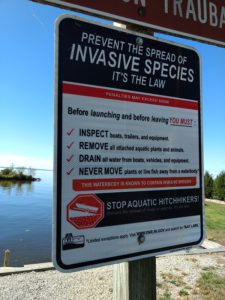Every month, we will put a spotlight on an aquatic invasive species (AIS) in a re-occurring monthly article. This month, the Red Swamp Crayfish! Check it out!
Red swamp crayfish (Procambarus clarkii) is classified as an AIS in some states of the United States and native in others. With a native range that consists of  wetlands from Florida to Mexico and up through the southern Mississippi River, the red swamp crayfish is very common and well known to many southern states. However, more and more lakes and rivers across the non-native range of the crayfish have started to see populations of this invader. Many of these populations are likely to have been started through illegal aquarium releases. The bright red color and large size of the crayfish has led to the species being sold in stores advertised as a “freshwater lobster”.The red swamp crayfish is also a popular pet in classrooms and may be released at the end of the school year. Anglers commonly use the crayfish as bait in many states. However, several states including Wisconsin have made it illegal to use live crayfish as bait to help stop the spread of this invasive species.
wetlands from Florida to Mexico and up through the southern Mississippi River, the red swamp crayfish is very common and well known to many southern states. However, more and more lakes and rivers across the non-native range of the crayfish have started to see populations of this invader. Many of these populations are likely to have been started through illegal aquarium releases. The bright red color and large size of the crayfish has led to the species being sold in stores advertised as a “freshwater lobster”.The red swamp crayfish is also a popular pet in classrooms and may be released at the end of the school year. Anglers commonly use the crayfish as bait in many states. However, several states including Wisconsin have made it illegal to use live crayfish as bait to help stop the spread of this invasive species.
Red swamp crayfish are dark red in color with long claws. Typically, the species gets up to 5 inches in length. The most distinguishing feature of this AIS are the raised bright red spots that cover the body and claws. Red swamp crayfish can survive in a variety of salinities,  water temperatures, and oxygen levels that allow the species to invade many different kinds of waterbodies including lakes, rivers, wetlands, canals, and storm water ponds. These crayfish construct chimney-like burrows with a single opening that widens into a chamber in the sediment.
water temperatures, and oxygen levels that allow the species to invade many different kinds of waterbodies including lakes, rivers, wetlands, canals, and storm water ponds. These crayfish construct chimney-like burrows with a single opening that widens into a chamber in the sediment.
Red swamp crayfish are omnivores that will eat plant materials, animals, and any detritus across the bottom of the waterbody. Breeding occurs in the autumn and females can produce as many as 500 eggs. It takes as little as six weeks for eggs to be made but the crayfish have an eleven week period as eggs incubate and mature. Red swamp crayfish have been found carrying eggs or young year-round under their tails. This can help lead to the establishment of a population in newly invaded waters. Red swamp crayfish also are able to travel to new waterbodies over land and have been documented to travel over 10 miles over four days. Red swamp crayfish typically live only two to five years.
to travel to new waterbodies over land and have been documented to travel over 10 miles over four days. Red swamp crayfish typically live only two to five years.
The impact of the invasive red swamp crayfish is similar to the rusty crayfish. They feed heavily on fish eggs, small fish, insects, aquatic plants, and detritus (decaying plants and animals). Red swamp crayfish are typically larger than native crayfish species and will actively push native species out of habitat. Similar to rusty crayfish, red swamp crayfish also feed on plants by cutting stems when feeding. This can facilitate the spread of other invasive species such as Eurasian watermilfoil that can potentially form new plants when a piece of the plant float away.
In Wisconsin, red swamp crayfish are Prohibited in all counties. Currently, Red Swamp Crayfish are not found in the Winnebago System or Upper Pool Lakes.
Want to help? HELP PREVENT THE SPREAD!
Every time you come off the water, make sure to follow these steps to stop the spread of faucet snails and other aquatic invasive species:
* Inspect boats, trailers, push poles, anchors, and other equipment for attached aquatic plants or animals.
* Remove all attached plants or animals
* Drain all water from boats, motors, livewells and other equipment
* Never move live fish away from a waterbody
* Never release aquarium plants or animals into your local waterways
Follow the Fox Wolf Watershed Alliance’s Winnebago Waterways Program on our Winnebago Waterways Facebook page or @WinnWaterways on Twitter! You can also sign-up for email updates at WinnebagoWaterways.org.
Questions? Comments? Contact Chris Acy, the AIS Coordinator for the Winnebago Waterways Program covering Fond du Lac, Calumet, Outagamie, and Brown and Winnebago Counties at (920) 460-3674 or chris@fwwa.org!
Winnebago Waterways is a Fox-Wolf Watershed Alliance program. The Fox-Wolf Watershed Alliance is an independent nonprofit organization that identifies and advocates effective policies and actions that protect, restore, and sustain water resources in the Fox-Wolf River Basin.
All text from this article is from the Winnebago Waterways AIS Strategic Plan. Sources can be found in the AIS Strategic Plan document.
Photo Credit: Brad Steckart, Chris Acy, Luc Hoogenstein
